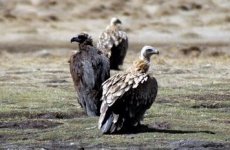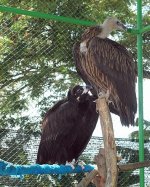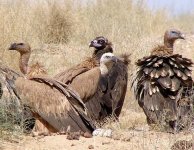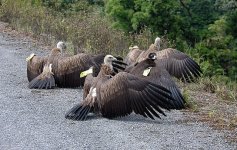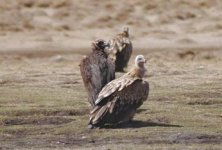Really?
When I compared the chromosome sets of New World vultures with those of storks, they were identical. Old World vultures, eagles, hawks and falcons have all different patterns, but stand out as a group from all other birds.
The chromosome set of a New World vulture consists of a few very large pairs of chromosomes, several smaller pairs and 40 to 50 pairs of tiny to minute pairs of chromosomes.
This size difference and large number is typical for most birds, but not so in Falconiformes. Old World vulture chromosome patterns seem to be from an ancient stem. The European Short-toed Eagle has the same pattern, strangely enough.
The Lammergeier is believed to have descended from the Old World vultures, as can be retrieved by some modifications in the chromosome set.
I would like to know on what evidence the AOU now classifies the New World vultures as Falconiformes. I admit it was a while back I studied genetics ( 1980 ) so I'm not keeping up with new developments.
Regards, Ronald
I'm just passing on what I've read. I'm not a professional biologist and don't have a personal opinion on cathartid classification.
Anyway, here are the relevant excerpts from the 48th supplement (together with the most recent references) so you can judge for yourself. Avian taxonomy is obviously a fast moving field.
"p. 51. Reconsideration of the evidence for moving the family Cathartidae from the order Falconiformes to the order Ciconiiformes (AOU 1998), re-evaluation of the analysis of Griffiths (1994), and preliminary information from continuing genetic studies (e.g., Cracraft et al. 2004, Fain and Houde 2004, Ericson et al. 2006) indicate that the move was in error, although the true relationships and thus placement of the family are still not fully resolved.
Move the entries for the family Cathartidae and the included species (pp. 51-53) to a position in the Order FALCONIFORMES just before the Suborder ACCIPITRES (p. 86) under the heading Suborder CATHARTAE: American Vultures. Under the heading for the Family Cathartidae, insert the following:
Notes.—This family was moved to the order Ciconiiformes (AOU 1998) but is now tentatively returned to the order Falconiformes after re-evaluation of the reasons for the earlier change. Further, some genetic studies (Cracraft et al. 2004, Fain and Houde 2004, Ericson et al. 2006) have shown that the New World vultures are not closely related to the storks, although their precise phylogenetic relationship to the Falconiformes is yet undetermined."
Cracraft, J., F. K. Barker, M. Braun, J.Harshman, G. J. Dyke, J. Feinstein, S. Stanley, A. Cibois, P. Schikler, P. Beresford,and others. 2004. Phylogenetic relationshipsamong modern birds (Neornithes):Toward an avian tree of life. Pages 468–489 in Assembling the Tree of Life (J. Cracraft and M. J. Donoghue, Eds.). Oxford UniversityPress, United Kingdom.
Ericson, P. G. P., C. L. Anderson, T. Britton, A. Elzanowski, U. S. Johansson, M. Källerrsjö, J. I. Ohlson, T. J. Parsons, D.Zuccon, and G. Mayr. 2006. Diversifi cation of Neoaves: Integration of molecular sequence data and fossils. Biology Lett ers
2:543–547.
Fain, M. G., and P. Houde. 2004. Parallel radiations in the primary clades of birds. Evolution 58:2558–2573.





